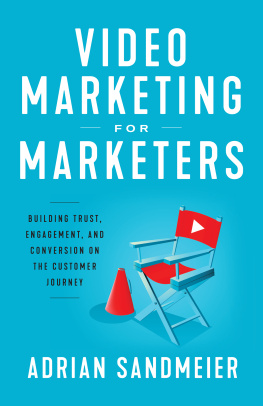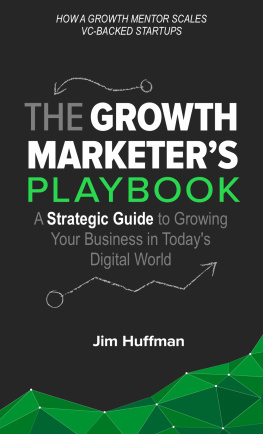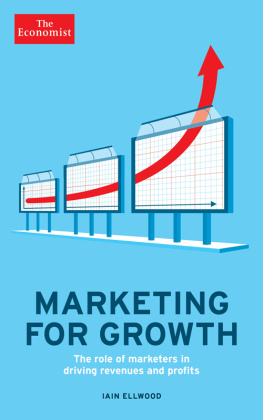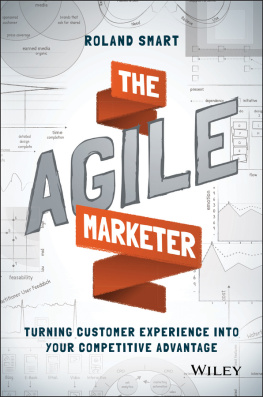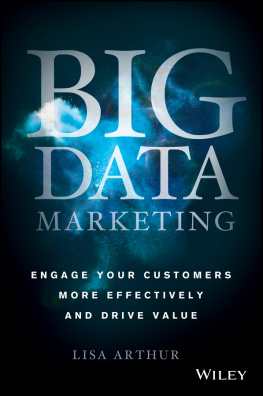Thomas Bauer - Marketing Performance: How Marketers Drive Profitable Growth
Here you can read online Thomas Bauer - Marketing Performance: How Marketers Drive Profitable Growth full text of the book (entire story) in english for free. Download pdf and epub, get meaning, cover and reviews about this ebook. year: 2016, publisher: Wiley, genre: Business. Description of the work, (preface) as well as reviews are available. Best literature library LitArk.com created for fans of good reading and offers a wide selection of genres:
Romance novel
Science fiction
Adventure
Detective
Science
History
Home and family
Prose
Art
Politics
Computer
Non-fiction
Religion
Business
Children
Humor
Choose a favorite category and find really read worthwhile books. Enjoy immersion in the world of imagination, feel the emotions of the characters or learn something new for yourself, make an fascinating discovery.

- Book:Marketing Performance: How Marketers Drive Profitable Growth
- Author:
- Publisher:Wiley
- Genre:
- Year:2016
- Rating:4 / 5
- Favourites:Add to favourites
- Your mark:
- 80
- 1
- 2
- 3
- 4
- 5
Marketing Performance: How Marketers Drive Profitable Growth: summary, description and annotation
We offer to read an annotation, description, summary or preface (depends on what the author of the book "Marketing Performance: How Marketers Drive Profitable Growth" wrote himself). If you haven't found the necessary information about the book — write in the comments, we will try to find it.
Thomas Bauer: author's other books
Who wrote Marketing Performance: How Marketers Drive Profitable Growth? Find out the surname, the name of the author of the book and a list of all author's works by series.
Marketing Performance: How Marketers Drive Profitable Growth — read online for free the complete book (whole text) full work
Below is the text of the book, divided by pages. System saving the place of the last page read, allows you to conveniently read the book "Marketing Performance: How Marketers Drive Profitable Growth" online for free, without having to search again every time where you left off. Put a bookmark, and you can go to the page where you finished reading at any time.
Font size:
Interval:
Bookmark:

THOMAS BAUER
TJARK FREUNDT
JONATHAN GORDON
JESKO PERREY
DENNIS SPILLECKE

This edition first published 2016
2016 McKinsey & Company, Inc.
Registered office
John Wiley & Sons Ltd, The Atrium, Southern Gate, Chichester, West Sussex, PO19 8SQ, United Kingdom
For details of our global editorial offices, for customer services and for information about how to apply for permission to reuse the copyright material in this book please see our website at www.wiley.com.
The right of the author to be identified as the author of this work has been asserted in accordance with the Copyright, Designs, and Patents Act 1988.
All rights reserved. No part of this publication may be reproduced, stored in a retrieval system, or transmitted, in any form or by any means, electronic, mechanical, photocopying, recording, or otherwise, except as permitted by the UK Copyright, Designs and Patents Act 1988, without the prior permission of the publisher.
Wiley publishes in a variety of print and electronic formats and by print-on-demand. Some material included with standard print versions of this book may not be included in e-books or in print-on-demand. If this book refers to media such as a CD or DVD that is not included in the version you purchased, you may download this material at http://booksupport.wiley.com. For more information about Wiley products, visit www.wiley.com.
Designations used by companies to distinguish their products are often claimed as trademarks. All brand names and product names used in this book and on its cover are trade names, service marks, trademarks, or registered trademarks of their respective owners. The publisher and the book are not associated with any product or vendor mentioned in this book. None of the companies referenced within the book have endorsed the book.
Limit of Liability/Disclaimer of Warranty: While the publisher and author have used their best efforts in preparing this book, they make no representations or warranties with respect to the accuracy or completeness of the contents of this book and specifically disclaim any implied warranties of merchantability or fitness for a particular purpose. It is sold on the understanding that the publisher is not engaged in rendering professional services and neither the publisher nor the author shall be liable for damages arising herefrom. If professional advice or other expert assistance is required, the services of a competent professional should be sought.
Library of Congress Cataloging-in-Publication Data is available
A catalogue record for this book is available from the British Library.
ISBN 978-1-119-27833-7 (hbk)
ISBN 978-1-119-27829-0 (ebk) ISBN 978-1-119-27838-2 (ebk)
Cover design: Wiley
If your marketing department were publicly traded, would you buy a share? If the new campaign were a pay-TV channel, would you subscribe to it? If next year's media plan were a business proposition, would you invest in it? If you hesitate even for a split second and we would not be surprised this book is for you. To take its proper place among its fellow functions, marketing needs to evolve from a cost centre to a profit centre. As the CMO, or as an aspiring marketing leader, you don't want to ask the members of the board or the shareholders of your company for budget clearance. You want to present them with an investment opportunity. You don't want your marketing plan to be perceived as a necessary evil, but as a good business proposition. You want marketing to advance the performance of your company in predictable and sustainable ways. You rightfully aspire to generate returns on marketing investment, be it in terms of sales, profit, market share, or brand equity. Make it happen, and you will never have to justify a budgetary line item to the CFO again or smile and listen patiently as your fellow executives praise a competitor's creative campaign, asking why you never come up with something as clever as that, despite the fortune you are spending on all those hot-shot agencies. Sounds tempting? Then read on.
This is not a textbook for students of marketing theory. There are more than enough of those already. This a performance handbook for marketing practitioners. With trademark clarity, McKinsey's Marvin Bower defined performance as follows: By performance, I do not mean just profits. Rather, I mean achieving the goals and objectives of any type of organization in an effective and efficient manner, with profits being one measure of the success of a business firm. Responsible decision makers all seek to improve the performance of their organizations. In this spirit, we aspire to provide marketing executives with hands-on decision support across all major performance levers, from budgeting and mix optimization to vendor management and organization. In contrast, we will not explore the underlying theory in more detail than is necessary for the practical purposes of this book. If you want to know more, please refer to the more comprehensive discussion of many of the concepts presented here in PowerBrands, now in its third edition, and Retail Marketing and Branding, now in its second edition.
This is not even primarily a book about marketing. It is a book about return on investment, focused on how an ROI mindset will help you transform the marketing function into a profit centre. Our primary objective is to empower you to open up new areas of growth for your company. Of course we don't have all the answers. But we are confident that the success factors we have derived from our work with leading marketers will help you plan, measure, and optimize the contribution of the marketing function to corporate performance. We encourage you to initiate a conversation about strategic priorities, even if that is the last thing some executives expect from the CMO. Don't hesitate to take on the big issues: What, exactly, are our goals and objectives as a company? Top- or bottom-line growth? Market share or profit margins? Short-term sales or long-term loyalty? Defend the home turf or conquer new segments, categories, and territories? This book will help you explain to your fellow executives how their answers affect your decisions: Which investments do I focus on? What messages do I send to customers? Which marketing instruments take priority? What kinds of tools do I need?
This is not a scholarly treatise. You will find that this is a straightforward book, down to its clean-cut structure and accessible language. It reflects our belief that simple things can make a big difference, even in a complex world obsessed with ever more data, ever more elaborate algorithms, and ever more intricate processes. Complexity is the enemy of agility, a key asset in a changing environment. Big data and advanced analytics are not ends in themselves, but means to an end, and that end is better marketing performance. We advocate data-driven decision making not for its own sake, but because we are convinced that quantified metrics are indispensable complements of experience and common sense. We explore topics like systematic insight generation and advanced analytics not because they are fashionable, but because we have found that they help companies establish a culture of evidence-based performance management. This is also why we have included dozens of application examples and case studies from a wide range of industries and countries. These examples provide both proof of principle and inspiration for your own agenda.
Font size:
Interval:
Bookmark:
Similar books «Marketing Performance: How Marketers Drive Profitable Growth»
Look at similar books to Marketing Performance: How Marketers Drive Profitable Growth. We have selected literature similar in name and meaning in the hope of providing readers with more options to find new, interesting, not yet read works.
Discussion, reviews of the book Marketing Performance: How Marketers Drive Profitable Growth and just readers' own opinions. Leave your comments, write what you think about the work, its meaning or the main characters. Specify what exactly you liked and what you didn't like, and why you think so.

